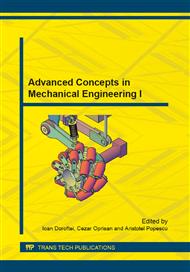[1]
Y. Ichikawa, N. Ozaki, K. Sadakane, A hybrid locomotion vehicle for nuclear power plants. IEEE Transactions Systems, Man and Cybernetics 13: 6 (1983) 1089–1093.
DOI: 10.1109/tsmc.1983.6313182
Google Scholar
[2]
M. Guihard, P. Gorce, J.G. Fontaine, Sapphyr: Legs to pull a wheel structure, in: Proceedings of IEEE International Conference on Robotics and Automation, Nagoya, Japan, 1995, p.1303–1308.
DOI: 10.1109/icsmc.1995.537952
Google Scholar
[3]
G. Muscato, G. Nunnari, Legs or wheels? Wheeleg - a hybrid solution, in: G.S. Virk, M. Randall, and D. Howard (Eds. ), Proceedings of the 2nd International Conference on Climbing and Walking Robots - CLAWAR-99, Portsmouth, UK, 1999, p.173–180.
Google Scholar
[4]
V. Krovi, V. Kumar, Modeling and control of a hybrid locomotion system. ASME Journal of Mechanical Design 121: 3 (1999) 448–455.
DOI: 10.1115/1.2829482
Google Scholar
[5]
A. Halme, L. Leppanen, S. Salmi, Development of workpartner robot—design of actuating and motion control system, in: G.S. Virk, M. Randall, and D. Howard (Eds. ), Proceedings of the 2nd International Conference on Climbing and Walking Robots - CLAWAR-99, Portsmouth, UK, Professional Engineering Publishing, 1999, p.657.
Google Scholar
[6]
S. Hirose, H. Takeuchi, Study on roller-walk (basic characteristics and its control), in: Proceedings of IEEE International Conference on Robotics and Automation, 1996, p.3265–3270.
DOI: 10.1109/robot.1996.509210
Google Scholar
[7]
A. Halme, L. Leppanen, S. Salmi, S. Ylonen, Hybrid locomotion of a wheel-legged machine, in: M. Armada, P. Gonzalez de Santos (Eds. ), Proceedings of the Third International Conference on Climbing and Walking Robots - CLAWAR-2000, Madrid, Spain, 2000, p.167.
Google Scholar
[8]
Y.J. Dai, E. Nakano, T. Takahashi, H. Ookubo, H., Motion control of leg-wheel robot for an unexplored outdoor environment, in: Proceedings of the 1996 IEEE/RSJ International Conference on Intelligent Robots and Systems, vol. 2, Nov. 4-8, 1996, pp.402-409.
DOI: 10.1109/iros.1996.570803
Google Scholar
[9]
N. Eiji, N. Sei, Leg-wheel robot: a futuristic mobile platform for forestry industry, in: IEEE/Tsukuba International Workshop: Can Robots Contribute to Preventing Environmental Deterioration?, Nov. 8-9, 1993, pp.109-112.
DOI: 10.1109/icar.1993.337208
Google Scholar
[10]
K. Suwannasit, S. Laksanacharoen, A BIO-Inspired Hybrid Leg-Wheel robot. TENCON 2004, in: 2004 IEEE Region 10 Conference Proceedings - Analog and Digital Techniques in Electrical Engineering, 21-24 Nov. 2004, Chiang Mai, Thailand.
DOI: 10.1109/tencon.2004.1414978
Google Scholar
[11]
K. Suwannasit, S. Laksanacharoen, A Hybrid Leg-Wheel Robot, in: The 18th Conference of Mechanical Engineering Network of Thailand, KhonKan, Thailand, October 18-20, (2004).
Google Scholar
[12]
A. Conduraru (Slătineanu), I. Doroftei, I. Conduraru, An Overview on the Design of Mobile Robots with Hybrid Locomotion, Advanced Materials Research, 837 (2013) 555-560.
DOI: 10.4028/www.scientific.net/amr.837.555
Google Scholar
[13]
I. Doroftei, I. Ion, Design and Locomotion Modes of a Small Wheel-Legged Robot, in: K.J. Waldron, M.O. Tokhi, G.S. Virk (Eds. ), Nature-Inspired Mobile Robotics (Proceedings of the Conference on Climbing and Walking Robots, CLAWAR'2013), Sydney, Australia, 2013, pp.609-616.
DOI: 10.1142/9789814525534_0077
Google Scholar
[14]
I. Doroftei, C. Marta, C. O. Hamat, L. Suciu, G. Prisacaru, A Hybrid Wheel-Leg Mobile Robot, in: Katalinc B (Ed. ), ANNALS OF DAAAM FOR 2008 & PROCEEDINGS OF THE 19TH INTERNATIONAL DAAAM SYMPOSIUM, Book Series: Annals of DAAAM and Proceedings, Trnava, Slovakia, 2008, pp.425-426.
DOI: 10.2507/daaam.scibook.2009.44
Google Scholar
[15]
I. Doroftei, F. Adascalitei, A Hexapod Micro-Walking Robot with Compliant Legs. Applied Mechanics and Materials 162 (2012) 234-241.
DOI: 10.4028/www.scientific.net/amm.162.234
Google Scholar
[16]
I. Doroftei, Y. Baudoin, A Concept of Walking Robot for Humanitarian Demining, Industrial Robot-An International Journal 39: 5 (2012) 441–449.
DOI: 10.1108/01439911211249733
Google Scholar
[17]
J. -C. Habumuremyi and I. Doroftei, Mechanical design and MANFIS control of a leg for a new deminig robot, in: K. Berns, R. Dillmann (Eds. ) Proceedings of The 4th International Conference on Climbing and Walking Robots, CLAWAR'2001, 2001, pp.457-464.
Google Scholar
[18]
I. Doroftei, A. Preumont, Development of an Autonomous Micro Walking Robot with Articulated Body, in: G.S. Virk, M. Randall, and D. Howard (Eds. ), Proceedings of the 2nd International Conference on Climbing and Walking Robots - CLAWAR-99, Portsmouth, UK, 1999, pp.497-507.
DOI: 10.1049/ic:19960954
Google Scholar
[19]
A. Preumont, P. Alexandre, I. Doroftei, F. Goffin, A Conceptual Walking Vehicle for Planetary Exploration. Mechatronics 7: 3 (1997) 287-296.
DOI: 10.1016/s0957-4158(96)00043-8
Google Scholar


